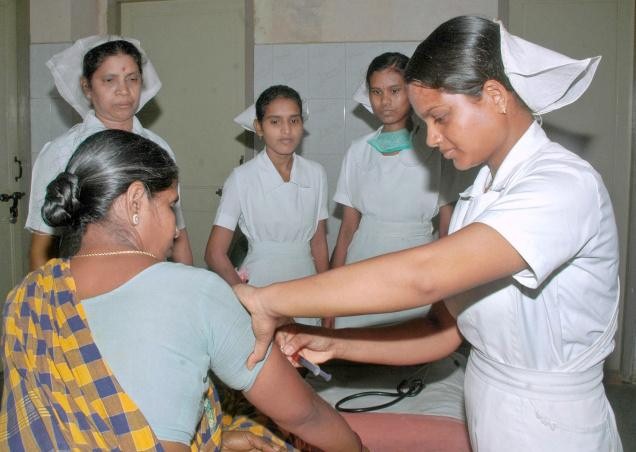The nursing shortage is alarming
 The healthcare industry is considered the world’s largest industry with total revenues of approximately US$ 2.8 trillion. In India as well, healthcare has become known as one of the largest service sectors offering employment to around 4 million people.
The healthcare industry is considered the world’s largest industry with total revenues of approximately US$ 2.8 trillion. In India as well, healthcare has become known as one of the largest service sectors offering employment to around 4 million people.
India can boast viable advantage over its peers in its large pool of well-trained medical professionals. Also, India has an upper hand in cost advantage compared to peers in Asia and Western countries. A surgery in India (minor or major) costs one-tenth of that in the US or Western Europe. While on one hand, the healthcare sector is booming and has a bright future; on the other hand, nursing shortage is becoming acute in India as well as many countries around the world.
In 2010, a World Health Organization report revealed that India alone needed 2.4 million more nurses; while in sub-Saharan Africa, shortages are having profound effects on health care. In Canada also a nursing shortage lingers on, with an expected 60,000 additional registered nurses needed by 2022.
The U.S. is also struggling with the rising shortage of nurses. The country is projected to experience a shortage of Registered Nurses (RN’s) that is expected to intensify as Baby Boomers age is increasing therefore number of patients swelling. The healthcare need therefore is growing in US. The nursing schools across the country are stressed while trying to expand capacity to meet the rising demand for care giver. US is already working on healthcare reforms. The American Association of Colleges of Nursing (AACN) is working with schools, policy makers, nursing organizations, and the media to address the shortage while trying attracting younger people’s attention to take up nursing as profession.
 The number of registered nurses (RN) is steeply falling. This situation is observed in both developing and developed nations all over the world. If we don’t address the nursing shortage immediately, it might result into a catastrophe. Because of the dropping nurses to patient ratio, many deaths are caused in hospitals. Also, this situation is increasing the workloads of existing nurses in hospitals which they are unable to bear.
The number of registered nurses (RN) is steeply falling. This situation is observed in both developing and developed nations all over the world. If we don’t address the nursing shortage immediately, it might result into a catastrophe. Because of the dropping nurses to patient ratio, many deaths are caused in hospitals. Also, this situation is increasing the workloads of existing nurses in hospitals which they are unable to bear.
We need to understand that nursing shortage is not essentially due to lack of supply of trained nurses in a country like India. In some cases, perceived shortages occur concurrently with enlarged admission rates of students into nursing schools. The shortage occurs due to lack of spirit of hospital managements to maintain adequate staffing ratios in hospitals, lack of healthcare facilities which force nurses to quit. We lack placement programs for newly trained nurses which are of great importance. Newly trained nurses at times don’t get opportunities to work. Lackluster attitudes of hospitals don’t even advertise the vacant nursing posts. Most importantly, inadequate salaries and retention incentives are the cause for the glaring shortage. Globally, the World Health Organization (WHO) estimates a shortage of almost 4.3 million nurses worldwide. This is due to decades of under investment in health worker education, good training facilities, illogical wage structure, bad work environment and heartless management.
We should realize that inflation hits everybody equally. While the inflation rates are raising nurse’s salaries are stagnant. Perhaps that’s the reason younger people are opting for better paying careers. Secondly, the workload of nurses is quite high, which has never been considered by policy makers. The nursing schools need to emphasize on clinical skills of nurses; this can be done by attaching more nursing schools to hospitals so that nurses are exposed to hands on experience. Many senior nurses have discussed their problems on various platforms; we need to empathize with their requirements. For example, to deal with Ebola problem, hardly any training is imparted to the nurses in private or government hospitals.
 A study by the Commonwealth of Australia identified matters that led to attrition of nurses. The report says that many younger nurses are thinking of changing their profession because of constant schedule changes, high load of patients, tedious paper work, fluctuating work shifts, most importantly lack of appreciation from superiors, lack of appreciation from patients and their relatives, bad work milieu and laughable pay scales.
A study by the Commonwealth of Australia identified matters that led to attrition of nurses. The report says that many younger nurses are thinking of changing their profession because of constant schedule changes, high load of patients, tedious paper work, fluctuating work shifts, most importantly lack of appreciation from superiors, lack of appreciation from patients and their relatives, bad work milieu and laughable pay scales.
Let’s look the parity in salaries in India; a nurse in foreign country earns Rs.2.00 lacs per month whereas in India she earns Rs.10,000 and little above depending on her experience. Saroja Jayakumar, chief nursing officer, Manipal Hospital, has said this in one of interviews with Times of India that “The prime reason for shortage of nurses is poor salary”. In an interview, Dr Ajith Benedict Royan, vice-president, medical administration, Hosmat Hospital and Nursing College says that earlier many women from Kerala would opt for nursing profession. But, today, nursing is found less lucrative compared to other professions like engineering. Nurses from Kerala also prefer to work in foreign countries as they have an opportunity to earn high salaries there. The number of men opting for this profession is lesser. Kearala has supplied nurses globally. You go to any part of world, you are sure to find at least one or two Keralite nurses in hospitals.
Dr Devi Prasad Shetty, chairman, Narayana Hrudayalaya, feels that if nurses are not offered enhancement in their careers like the US offers, why would younger generation opt for a dry and lesser paying profession? In US, graduate nurses can pursue courses in anesthesia to become nurse-anesthetists. They can also become interventionists and earn as much as a doctor. Can we offer such training in India? Unless our policy-makers take concrete steps in enhancing syllabus for nursing, there is no much hope to attract younger people to opt for this profession.
The policy makers need to spend some time to brainstorm workable solutions. We need to offer specialization in nursing courses. Reshape the nursing course syllabus by updating it for present over reliance on technology needs, upgrade the clinical facilities in nursing schools, and last but not the least revamp the policies in appointment of nurses by upgrading their pay scales. We need to take immediate steps and strategies to solve the increasing shortage of nurses. Nurses are one resource we simply cannot afford to do without. We therefore, need to put bandage on it to cure this problem.
In the words of Dag Hammarskjold “Constant attention by a good nurse may be just as important as a major operation by a surgeon.”













































